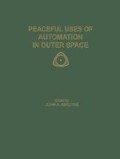Abstract
The main design factors for a satellite communications ground station are reviewed and various sections of the stations, where the design is critical, especially the antenna and drive systems, are discussed in more detail with regard to recent results and proposals.
The system design is normalized with respect to the maximum power flux recommended by CCIR, and it is found that present satellite systems do not even approach this maximum level.
In the system design, influences of various sorts, f.ex. influence of heavy precipitation is included.
In a design example, considering only the receiver part of the station, power flux levels comparable to that of early experimental satellites are used and it is concluded, that a Cassegrain type of antenna with a nitrogen cooled parametric amplifier tends to be the most economical for station sites outside tropical regions.
In some tropical regions, additional attenuation due to heavy precipitation will require antenna areas far in excess of those currently used (up to app. 25 meters diameter), if the present rather low power flux from satellites is used.
Then, if the transmitter power and/or antenna gains for the satellites are increased to compensate for this, stations in temperate climates will probably be designed with antenna areas determined by their function as transmitters and/or by interference consideration rather than by their function as a part of a low noise receiver.
Access this chapter
Tax calculation will be finalised at checkout
Purchases are for personal use only
Preview
Unable to display preview. Download preview PDF.
Literature
Bracewell (1961): Tolerance Theory of Large Antennas, IRE Trans. on Antennas and Propagation, vol. AP-9, Jan 1961, no.1, pp.49.
Canfield (1959): Gearless Drive for Power Servo. Electrical Manufacturing, pp. 142-, Jan 1959.
Caspar S Sandreczki (1964): Ice Deposits from the Meteorological Standpoint. Elektrotechnische Zeitschrift, Ausg.B, vol.16, Dec 18, 1964, no.26, pp. 763–768.
Cuccia (1964): How to Buy a Low-Noise-Traveling-Wave Tube? Microwaves, Sep 1964, pp. 70.
Dragone S Hogg (1963): Wide-Angle Radiation Due to Rough Phase Fronts. The Bell System Technical Journal, vol. 42, Sep 1963, no.5, pp. 2285.
Feldman (1964): Estimates of Communication Satellite System Degradation Due to Rain. AD 609.427, Oct 1964.
Foldes (1962): The Capabilities of Cassegrainian Microwave Optics Systems for Low Noise Antennas. Solid State Electronics, vol.4, pp. 319-, Oct 1962.
Galindo (1964): Design of Dual Reflector Antennas with Arbitrary Phase and Amplitude Distributions. IEEE Trans. on Antennas and Propagation, vol. AP-12, July 1964, no.4, pp. 403–408.
Gray (1964): Estimating the Effect of Feed Support Member Blocking on Antenna Gain and Side-Lobe Level. Microwave Journal, March 1964.
Hannan (1961): Microwave Antennas Derived from the Cassegrain Telescope. IRE Trans. on Antennas and Propagation, vol. AP-9, March 1961, no.2, pp. 140-.
Hines (1963): The Electrical Characteristics of the Conical Horn-Reflector Antenna. Bell System Technical Journal, vol. 42, pp. 1187-, July 1963.
Hirst & McKee (1964): Wind Forces on Parabolic Antennas. Bulletin 602, Andrew Corporation, Chicago, Aug 1964.
Hogg S Semplak (1964): An Experimental Study of Near-Field Cassegrainian Antennas. The Bell System Technical Journal, vol. 43, Nov 1964, no.6, pp. 2677–2705.
Hogg & Semplak (1961): The Effect of Rain and Water Vapour on Sky Noise at Centimeter Wavelengths. Bell System Technical Journal, vol. 40, pp. 1331-, Sep 1961.
Holzer (1965): Atmospheric Attenuation in Satellite Communications. Microwave Journal, vol. 8, pp. 119-, March 1965.
Jensen (1963): A Low-Noise Multimode Cassegrain Monopulse Feed with Polarization Diversity. NEREM Record 1963, Session 11: Antenna Feed Systems, pp. 94-96.
Lundh (1965): Styrningen av radioteleskopet på Råö. Teknisk Tidskrift, nr. 18, 1965, pp. 479-82.
Morgan (1964): Some Examples of Generalized Cassegrainian and Gregorian Antennas. IEEE Trans. on Antennas and Propagation, vol. AP-12, Nov 1964, no.6, pp. 685-91.
Potter (1963): Aperture Illumination and Gain of a Cassegrainian System. IEEE Trans. on Antennas and Propagation, vol. AP-11, pp. 373-, May 1963.
Potter (1962): The Application of the Cassegrainian Principle to Ground Antennas for Space Communications. IRE Transactions, vol. SET-8, pp. 154-, June 1962.
Potter (1964): The Design of a Very High Power, Very Low Noise Cassegrain Feed System for a Planetary Radar. Jet Propulsion Lab., Rept. no. 32-653, Aug 24, 1964.
Rayenscroft (1962): Primary Feeds for a Satellite Communication Aerials. Internat. Conf. on Satellite Comm., 22–28 Nov 1962, pp. 154-.
Rolinski et al. (1964): Satellite Tracking Characteristics of the X-Y Mount for Data Aquisition Antennas. NASA TN D-1697, June 1964.
Rolinski et al. (1962): The X-Y Antenna Mount for Data Acquisition from Satellites. IRE Trans., vol. SET-8, pp. 159-, June 1962.
Rule (1963): Problems of Large Radio Telescopes. Symposium on Engineering for Major Scientific Programs, Feb 5–6, 1963, Georgia Inst. of Techn., pp. 34-56.
Ruze (1952): Physical Limitations on Antennas. Research Laboratory of Electronics, MIT Tech. Report no. 248, Oct 30, 1952.
Ruze (1964): Reflector Tolerance Determination by Gain Measurement. NEREM Record 1964, pp. 166-167.
Stallard (1964): Servo Problems and Techniques in Large Antennas. IEEE Trans. on Applications a. Industry, March 1964, no. 71, pp. 105-114.
Victor (1961): Ground Equipment for Satellite Communications. Jet Propulsion Lab., Tech. Report no. 32-137 (N 62 10817), Oct 30, 1961.
Viggh (1963): Designing for Desired Aperture Illuminations in Cassegrain Antennas. IEEE Trans. on Antennas and Propag., vol. AP-11, March 1963, no.2, pp.198-.
Visocekas (1964): Noncassegrainian Indirect System for Aerial Illumination. Proceedings of the IEE, vol. 111, Dec 1964, no.12, pp. 1969–76.
Wilkinson S Appelbaum (1961): Cassegrain Systems. IRE Trans. on Antennas and Propagation, vol. AP-9, Jan 1961, no.l, pp. 119-.
Willoughby (1962): Egg Crate Reflector Surface for Large Paraboloids. Proceedings IRE, vol. 50, no.12, Dec 1962, pp. 2521–2522.
Author information
Authors and Affiliations
Editor information
Editors and Affiliations
Rights and permissions
Copyright information
© 1966 Springer Science+Business Media New York
About this paper
Cite this paper
Lund, C.O. (1966). On the System Design of Low-Cost Ground Stations for Satellite Communications. In: Aseltine, J.A. (eds) Peaceful Uses of Automation in Outer Space. Springer, Boston, MA. https://doi.org/10.1007/978-1-4899-6411-3_24
Download citation
DOI: https://doi.org/10.1007/978-1-4899-6411-3_24
Publisher Name: Springer, Boston, MA
Print ISBN: 978-1-4899-6203-4
Online ISBN: 978-1-4899-6411-3
eBook Packages: Springer Book Archive

